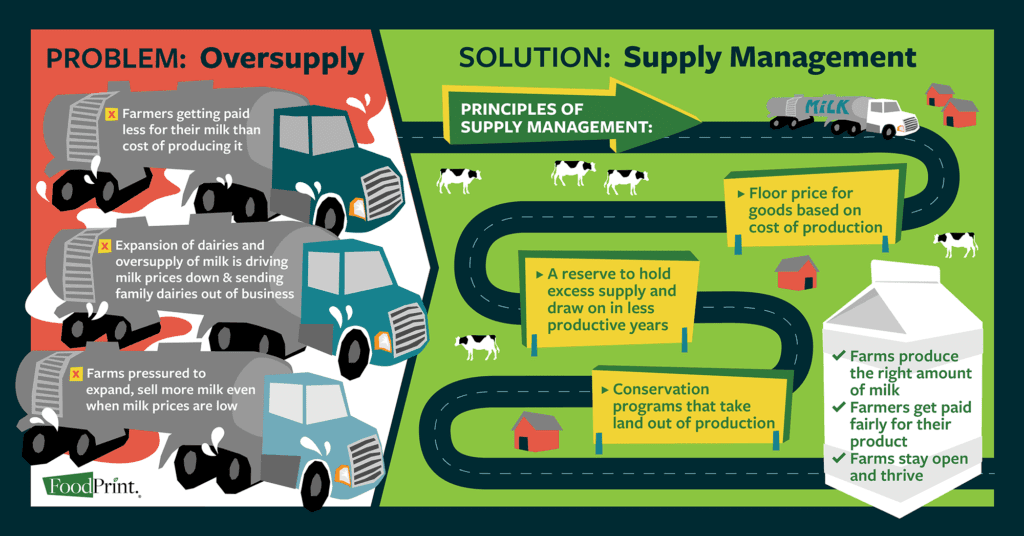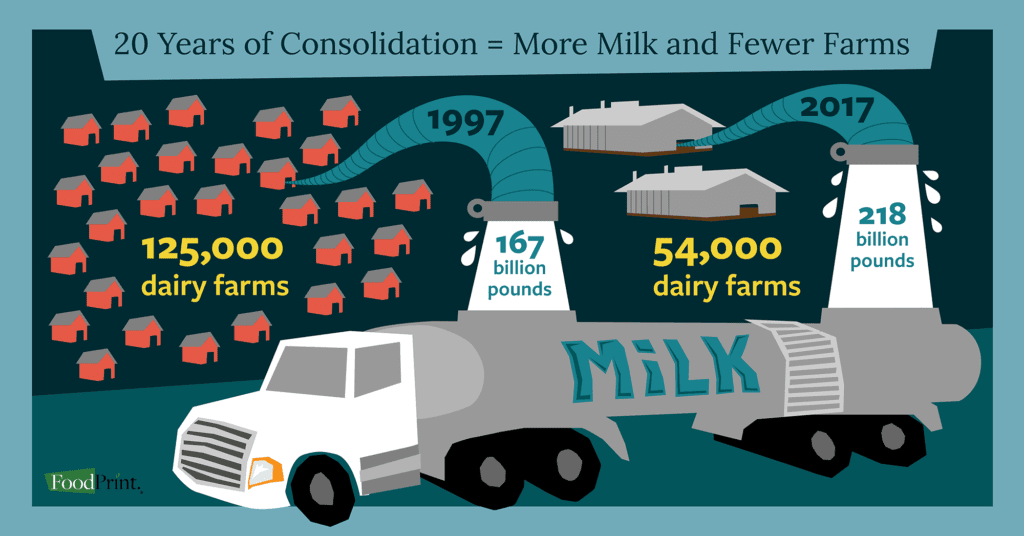New Report Explores Solutions to the US Dairy Crisis
Across the country, longtime family farmers are making the heart-wrenching decision to sell their dairy cows. Some are transitioning their farm to beef or crops in an effort to be more profitable, others are getting out of farming entirely. Since the beginning of 2018, two dairy farms a day have gone out of business in Wisconsin, the country’s second-largest dairy producer. The trends are similar in all dairy states. Last summer, a New England dairy cooperative sent its members information about mental health services and a suicide prevention hotline along with their milk checks. What’s causing this crisis in dairy country?
FoodPrint’s latest report, The FoodPrint of Dairy, takes a deep dive into all aspects of the dairy industry, from cow comfort to community economics, and sorts out what choices you can make at the grocery store and beyond to support a healthy dairy industry. Below, I outline the basics of the crisis.
Dairy Prices are Too Low
The chief problem is that milk prices are at a near-record low for farmers. In the last year, farmers have been paid $16 for 100 pounds of milk (about 12 gallons), while those hundred pounds cost about $23 to produce. Income has been well below costs since 2015, so that many farmers are under a mountain of debt while figuring out how to pay today’s expenses. Even if family members are working jobs off the farm, four years of negative net farm income mean farmers can’t pay for feed, seed, vet visits, equipment repairs – or even for heat, electricity or food.
Prices are so low because there is a glut (oversupply) of milk. US dairies are producing more milk (more on that in a minute), while the market keeps shrinking: Americans are drinking less of it, and in recent months, dairy, like other farm products, has been caught up in President Trump’s trade wars. In response to the president’s tariffs on foreign steel and aluminum, Canada, Mexico, Europe and China slapped retaliatory tariffs on US dairy products, shrinking all of those markets. Exports to China are facing another problem: Chinese hogs are fed a great deal of US whey, a cheese byproduct, but now the Chinese pork industry has been hit hard by swine fever, reducing the herd – and the need for US whey.
It’s basically a simple question of supply and demand: too much milk and not enough buyers equals low prices for farmers.

Drowning in Milk
But it’s not all China’s fault; it’s also California’s.
Let’s look at that glut of milk. As all those family dairy farms close, big dairy operations – with 1,000 cows or more – just keep growing. More cows are producing ever more milk, but on fewer farms. A lot of these “megadairies” are in California, but they’re rapidly expanding in the west and elsewhere across the country, in states like Wisconsin and Pennsylvania where farms have traditionally been small. In 1997, there were 125,000 US dairy farms milking 9 million cows. Twenty years later, in 2017, we were down to 54,000 dairy farms, yet they were milking 400,000 more cows. In roughly the same period, US milk production increased from 167 billion pounds to 218 billion pounds per year. Over half of 2017 milk sales were from megadairies with over 1,000 animals, with fully one-third of sales from dairies with over 2,500 cows. The biggest megadairies, which are increasingly common, have ten times that — 25,000 or even 30,000 animals.
But for you, as a consumer, why does it matter? It’s sad that the family farms are going out of business, but big operations can produce milk more cheaply, right? It’s not quite so simple. Megadairies have a ton of hidden costs, from animal welfare to worker rights abuses to environmental disaster.

Problems with Megadairies
A recent video showing abuse of dairy calves at Fair Oaks Farm is just the latest undercover video to show such atrocities at a megadairy. Apart from such clear abuse, cows in megadairies are often housed in crowded conditions, on hard surfaces that damage their hooves, and pushed to produce so much milk that their bodies are worn out and they are sent to slaughter after just a few years. Dairy workers, too, are commonly mistreated at these facilities, working long days for low pay, in dirty and sometimes dangerous conditions. Housing is often substandard and overcrowded, and workers, who are frequently immigrants with limited English skills, feel isolated in rural areas.
In addition to human and animal welfare concerns, megadairies are a disaster for local communities. A 2,000-cow dairy produces almost 90 million pounds of manure annually, which is stored in open ponds called lagoons. Lagoons release methane and other noxious and climate-heating gasses into the air, and they are prone to leaks and overflows. The untreated waste is regularly pumped from the lagoon and spread onto cropland as fertilizer, often at rates higher than the soil can absorb, causing it to run off into streams and rivers or seep into groundwater.
When a megadairy moves in next door – or even a mile away – residents find their lives turned upside down. People report odors so bad they can’t go outside; contaminated wells, requiring them to buy drinking water; and plummeting property values due to the smells, flies and noise.
A Better Glass of Milk
But it doesn’t have to be this way. Around the country, people are organizing in support of supply management, a dairy policy that would shrink the huge glut of milk, give family dairy farmers a fair price for what they produce, and stop the growth of megadairies. At the same time, the market for grassfed dairy – from cows who spend their lives grazing on pasture rather than living indoors – is booming, providing a better quality product to consumers and another possibility for farmers who are able to transition their herds to grass.
Read more about the path forward to a better dairy system in the report, The FoodPrint of Dairy.
More Reading
Do organic waste bans and composting programs really take a bite out of food waste?
March 17, 2025
What could massive cuts to SNAP benefits mean for the U.S. economy – and for all of us?
February 20, 2025
The EPA finally acknowledged the risks of PFAS in sewage sludge. What’s next?
February 10, 2025
How we came to rely on emergency food
September 30, 2024
Is flawed food policy responsible for listeria outbreaks in deli meats?
August 13, 2024
What does USDA’s new nutrition rule mean for school meals?
June 7, 2024
Limits for PFAS in drinking water signal a new phase in federal action on 'forever chemicals'
May 1, 2024
A new report envisions federal food spending as a force for good
January 3, 2024
It’s Been a Big Year for the Labor Movement. What About Farmworkers?
August 31, 2023
Escalating U.S.-Mexico Debate over Corn Forces Questions about GMOs, Food Sovereignty
June 5, 2023
